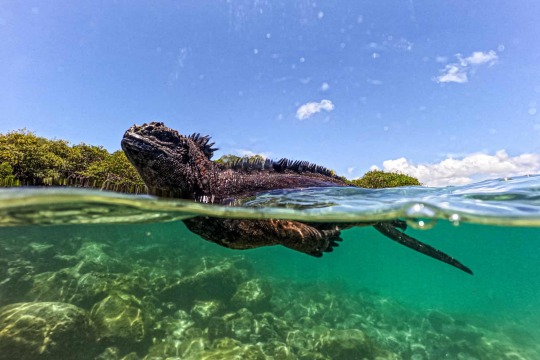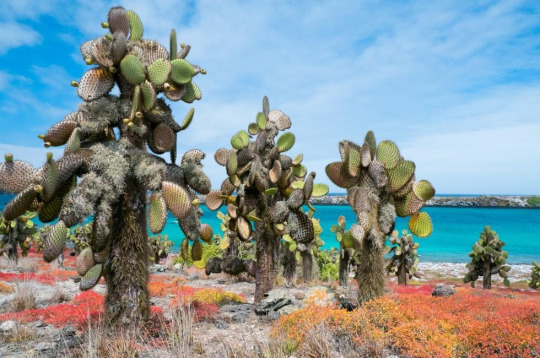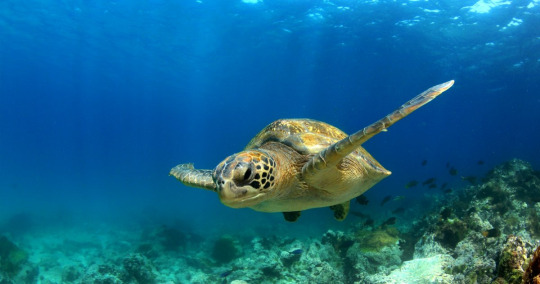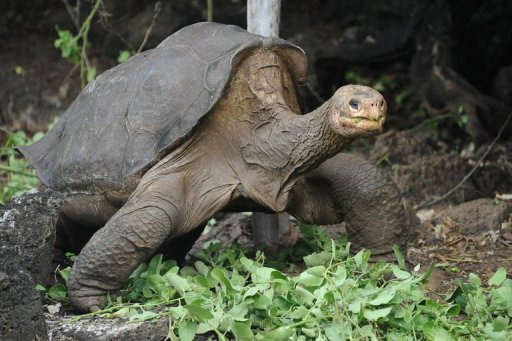#the galapagos islands
Explore tagged Tumblr posts
Text




Roccella nigerrima
Why are there so few pictures of this lichen on the internet? Well maybe because it is only found on the Galapagos Islands, and when people go to the Galapagos, they're not usually there to take pictures of the lichens, unfortunately. But like, how could you not want to take pictures of this beautiful little critter? This fruticose lichen has pale white-gray, terete, many-branched thallus, and grows on costal rocks and cliffs. It produces ochre to pale brown soredia along the lower branches, and has only been found with apothecia on one occasion. There are 2 very similar Roccella species native to South America, but they both have a C+ reaction whereas R. nigerrima here has a C- reaction. So you know, if you are ever traveling in the Galapagos and happen to have some bleach on you for chemical testing of lichens and are able to ID this little guy, definitely snap some pictures! For me, for yourself, and for the lichenology community at large.
images: source | source | source
info: source
#lichen#lichens#lichenologist#lichenology#mycology#ecology#biology#fungi#fungus#nature#galapagos#Galapagos Islands#the natural world#beautiful nature#weird nature#symbiosis#symbiotic organisms#algae#Roccella nigerrima#Roccella#I'm lichen it#lichen a day#daily lichen post#lichen subscribe#life science#environmental science#natural science#go outside#take a hike#look for lichens
780 notes
·
View notes
Note
A hydra, but each head has jaws and teeth specialized for different food like a one-creature set of the Galapagos Finches

#smaugust#hydra#dragon#suggestion#imagine if you cut the head of the hydra 2 heads appear but the new one has slightly evolved to adapt#y-psigon#a lot is going on this design#somehow when i was little i had a period where i was obsessed with the fauna of galapagos islands so i'm really glad to do this suggestion#the branches and the heads follow the phylogenic tree of the Darwin finches#the overall shape is based on those pictures of tiny islands with 1 single palm tree#the tortoise and iguanas used are from the island too#finch#bird#tortoise#iguana#reptile#Galapagos#Darwin#evolution#the Unknown#990#octem 124#aer 4#monster#chimera#bestiary#creature design#ink
457 notes
·
View notes
Text

Article
"2023 was a banner year for the Galapagos Islands: that wondrous archipelago so famous for its giant tortoises and other endemic species.
The long-serving conservation organization the Galapagos Conservancy, also endemic to the islands, recently published its annual report featuring standout figures like over 500 giant tortoises of 5 different species reintroduced to their natural habitat.
Additionally, a critically endangered species of albatross was identified to use giant tortoise feeding sites as take-off and landing areas. This key insight into co-dependency has given the Conservancy confidence that they can restore the populations of both animals to stable, flourishing numbers.
It underscores how far a donation to these endemic wildlife organizations really does go, and these two highlights of a successful year were only possible by the over $6 million in charitable contributions from supporters.
30 Chelonoidis chatamensis tortoises endemic to the smaller island of San Cristobal were repatriated to their natural habitat from the stock of a captive breeding program, while 97 native tortoises were returned to the second-largest island of Santa Cruz.
On the largest island of Isabella, 350 tortoises (214 C. guntheri and 136 C. vicina) were successfully reintroduced to their natural habitat after a survey found their numbers were not rising substantially on their own.
In March, the repatriation of 86 juvenile Chelonoidis hoodensis tortoises significantly contributed to enhancing the species’ distribution across their native habitat. They currently number 3,000 today on Española or Hood Island, a miraculous recovery from the 14 found there in the 1960s.
Also on Española, the endemic waved albatross was found to be taking off and landing on 50 additional parts of the island. These large birds, boasting an 8-foot wingspan, need ample space to get a running start before taking off, and this same principle applies when applying the brakes coming down from the sky.
In the survey, the biologists observed that concentrations of giant tortoises were linked with the usage of areas as runways for the albatross. Because the tortoises are the largest herbivores in the ecosystem, they perform the same acts as bison do in North America and Europe, and elephants in Africa—clear space.
With their herbivorous diet and large bulk, the tortoise’s feeding habits produce cleared areas ideal for albatross use.
“This discovery underscores the interconnectedness of the Galápagos ecosystem,” the authors of the report write. “This newly acquired knowledge allows us to strengthen the synergies between our conservation strategies.”
Of the $6.1 million received from donations and through other activities, the Conservancy was able to spend 77% of that on conservation programs, and that included some ambitious plans for this year—now already half done—which included drafting plans for restoration of the Pinta tortoise to the island of the same name, preparing tortoises for imminent reintroduction to the smaller Floreana island, and completely restoring the habitat for the Galapagos petrels on Santa Cruz.
Operating since 1985, the Galapagos Conservancy has a long track record of restoring these islands to their pre-Colombian glory. Let’s hope 2024 is as successful."
-via Good News Network, July 19, 2024
#galapagos#tortoise#galapagos islands#conservation#biodiversity#albatross#reptile#reptiblr#endangered species#wildlife conservation#ecosystems#climate action#conservation news#good news#hope
566 notes
·
View notes
Text
i love how heath was all

"this thing... i dont even know if its a pokemon. its incomprehensible!" and then its just

a lil guy
#pokemon sv spoilers#pokemon scarlet and violet#pokemon spoilers#pokemon presents#pokemon sv dlc#terapagos#galapagos islands thats funny
2K notes
·
View notes
Text

Santa Cruz Island, Ecuador
A marine iguana (Amblyrhynchus cristatus) swimming in Tortuga Bay, part of the Galapagos archipelago. Greenpeace has called for the creation of a high seas marine protected zone under a new UN treaty to secure a much wider area around Ecuador’s Galapagos archipelago
Photograph: Ernesto Benavides/AFP/Getty Images
#ernesto benavides#photographer#afp via getty images#santa cruz island#ecuador#marine iguana#iguana#reptile#amblyrhynchus cristatus#tortuga bay#galapagos archipelago#nature
60 notes
·
View notes
Text

This’ll be Ishmaels devyat id trust.
#limbus company#Ishmael lcb#based on hermann melvilles hatred for penguins#in his Galapagos island little excerpts#calls them terrible eating and badly made
54 notes
·
View notes
Text

Preening is a common mating and bonding ritual between mated birds. It serves as a way to erode their normal spatial instincts to attack or avoid another animal in close range
(Nazca boobies)
#photography#art#outdoors#nature#animals#digital art#wildlife#adventure#birds#outdoor#galapagosexpeditionann#galapagos islands#galapagos#travel#travelphotography
807 notes
·
View notes
Photo

A crevice made from volcanic stone, a home base for several tintoreras sharks peacefully resting during the day. Galapagos Islands, Ecuador
981 notes
·
View notes
Text

Turtle Tortuga, Galapagos Islands, Ecuador: The Galápagos Islands are an archipelago of volcanic islands in the Eastern Pacific, located around the Equator 900 km west of South America. They form the Galápagos Province of the Republic of Ecuador. The province is divided into the cantons of San Cristóbal, Santa Cruz, and Isabela, the three most populated islands in the chain. The Galápagos are famous for their large number of endemic species, which were studied by Charles Darwin in the 1830s and inspired his theory of evolution by means of natural selection. All of these islands are protected as part of Ecuador's Galápagos National Park and Marine Reserve. Wikipedia
102 notes
·
View notes
Text

Galápagos Giant Tortoise (Chelonoidis nigra), family Testudinidae, Galapagos Islands, Ecuador
This species is the largest terrestrial reptile in the world.
photograph by wapiti8 | Flickr
#tortoise#turtle#chelonoidis#testudinidae#reptile#herpetology#galapagos islands#south america#animals#nature
239 notes
·
View notes
Note
God... I never thought I would be thinking about Burningcheese Vampire AU. I even remembered our fella Vampire Cookie exists and that he is unaffected by the sun and can turn into a bat. That makes me wonder, can Golden Cheese turn into a complete bird in the AU? Just to have the buff man caging her with just his hands. What about if Burning Spice is the vampire? He would go bat, another flying animal or just another animal? Or are we just sticking with bats?
I hate being caught with my pants down like this, so to speak, but I actually haven't thought about it 😅 The most I've delved into their powers is me wanting to deviate from vampire norm and have these particular vampires empowered by the sun and weakened by the moon. Not too much beyond that haha
But since I don't want to leave you hanging, and I do like exploring weird little AUs like this one...
It would be logical (and funny) if Golden Cheese did turn into a bird, yeah lol. But I think it might make more sense if she was... different? From the other ones. Bigger, more unique plumage (maybe colored or styled in a way that resembles her attire, maybe even a triangular pattern on her forehead), sharper beak and talons. But... still fitting within Burning Spice's arms without issue, of course. Easy enough for him to catch and play with, and squeeze when she's misbehaving...
For Burning Spice, I actually didn't want him to become a traditional animal necessarily. I confess that his appetite and behavior are less like a vampire's and more like a rakshasa's (demonic entity from Indian mythology, they are malevolent and extremely dangerous and many are man-eaters). He's "normal", he looks the same; but slowly, over time, the more he indulges his cannibalistic urges, the more monstrous he appears. He was cursed by a dying shaman as retribution for BS destroying his village, so I thought of having the curse become more "permanent" with time and refusal to change (ironic lol)
Additional point to above, Spice starts looking and acting more like a rakshasa the hungrier he gets. Deny him sustenance long enough and he starts losing control of himself. His body and mind start to change; he adopts more devil-like features, he becomes less rational/coherent, he gains physical strength but loses focus and coordination. He is EXTREMELY difficult to deal with if and when he deteriorates far enough, and Golden Cheese does absolutely everything in her power to prevent it (while also still trying to hide him. She keeps him with her so she can monitor him and mitigate any threat he poses to others. No one is supposed to know)
#fun fact! there actually is a bird species that drinks blood!#they're called vampire finches and they're native to the galapagos islands!#they turn to drinking blood when other food sources are scarce. they usually stick to seeds and bugs. but still. vampire birds lol#so you can imagine GC sort of taking after a vampire finch if you want#gotta cook up vampire designs for them both now damn...#cookie run kingdom#burningcheese#goldenspice#cookie run au
22 notes
·
View notes
Text
90 notes
·
View notes
Text
Galapagos Islands, Ecuador:






#nature#hiking#diving#swimming#galapagos#ecuador#pacific ocean#travel#naturecore#naturelovers#walking in nature#marine life#islands#charles darwin#biology#conservation#seals#sea turtle#tortoise#iguana#reptiles#blue footed booby#nature photography#green turtle#cacti#cactus#sea lion#pinniped
44 notes
·
View notes
Text
Animal of the Day!
Pinta Island Giant Tortoise (Chelonoidis abingdonii)

(Photo by Santiago Piedra)
Extinction Date- 2012
Habitat- Pinta Island
Size (Weight/Length)- 180 kg; 1.8 m
Diet- Cacti; Grasses; Berries; Leaves
Cool Facts- The Pinta Island giant tortoise was only found on Ecuador’s Pinta Island in the Galapagos archipelago. These gentle giants would sleep up to 16 hours a day and spend the rest of their time eating. They would feast on cactus pads and fruit along with coarse grasses. Pinta Island giant tortoises were the top herbivore of Pinta Island and played an important part in dispersing cacti seeds. When explorers and whalers first discovered the Galapagos, they released the slow moving and long living giant tortoises made the perfect meal and killed them in the thousands. Goats were later brought to Pinta Island and destroyed the vegetation the tortoises needed. The last Pinta Island giant tortoise, Lonesome George, was luckily saved and was an estimated 100 years old when he passed away on June 24, 2012. Today, every giant tortoise species that remains in the Galapagos are either endangered or critically endangered. Off site breeding efforts in zoos worldwide has boosted their populations considerably although it’s been a very, very slow process.
Rating- 13/10 (Possible hybrid tortoises remain in zoos today.)
#animal of the day#animals#tortoise#giant tortoise#reptile#friday#october 13#pinta island giant tortoise#lonesome george#biology#science#conservation#the more you know#extinct#extinctober#galapagos tortoise
187 notes
·
View notes
Text
Some gorgeous super 8mm film home movies (Galapagos islands late 60s? ) shot by the late Norma Mastin. Mastin was a teacher and lifelong, passionate photographer. Last year I picked up a collection of her home movies which documented her lengthy travel all over the globe spanning many decades. There’s a LOT to go through. But this was a beautiful start. Great color. Shot in a thoughtful, professional way.
151 notes
·
View notes
Text

Galápagos Islands
A school of brightly colored cardinalfish darting from the path of a Galápagos sea lion.
PHOTOGRAPH BY CRISTINA MITTERMEIER
#cristina mittermeier#photographer#galapagos islands#cardinalfish#marine photography#fish#galapagos sea lion#sea lion#animal#mammal#wildlife#nature#national geographic
78 notes
·
View notes